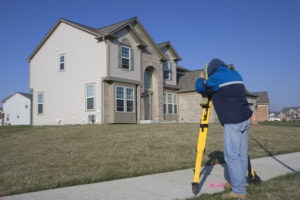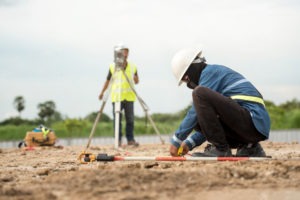
There are many types of surveys that a licensed land surveyor can perform on your property. But an elevation certificate is not the same as a survey. The information obtained in an elevation certificate is different from a traditional property survey, and different professionals utilize the different types of reports.
What Is an Elevation Certificate?
Elevation certificates provide information about your property’s flood zone, building characteristics, and lowest elevation point. Insurance companies use the elevation certificate data to evaluate your property’s flood risk.
Property owners in high-risk flood zones need to obtain a FEMA elevation certificate when seeking flood insurance. An insurance agent uses the certificate to determine the probability of a flood damaging the structures on your property.
In addition to property owners in flood zones, you may also need an elevation certificate if you are making substantial improvements that change your property’s lowest point of elevation. Examples of this include building underground additions or converting a basement into a living area.
Elevation Certificates vs. Land Surveys
Elevation certificates and land surveys are not the same. They are two different types of reports, each intended for varying purposes.
The most significant difference is that a boundary survey identifies a plot’s property lines, acreage, and physical structures. On the other hand, a flood survey establishes elevation levels on a plot of land.
Simply put: flood surveys help property owners understand their flood risk, while boundary surveys allow landowners to understand where their property ends and their neighbor’s plot begins.
Flood vs. Land Surveys: What’s Included
Flood surveys map out elevation points, while land surveys establish boundary lines and denote artificial and natural structures. Therefore, each type of survey contains different elements.
Flood elevation certificates include critical details about your property’s elevation levels. When creating these types of reports, a land surveyor will include:
- The lowest point of elevation on the property: The area of your property with the highest risk of flood damage based on FEMA guidelines.
- The plot’s flood zone: Your surveyor will indicate your flood zone based on your property’s risk of flooding. The zones use the letters A, V, B, C, X, or D to categorize the severity of the flood risk from low to high.
- The property’s building characteristics: Any notable structures on your property, including garages, sheds, and pools.
While boundary surveys may include building characteristics, they do not note a property’s flood risk or lowest point of elevation. Instead, these types of land surveys outline a property’s boundary lines and total acreage.
Flood Certificates vs. Land Surveys: Who Uses Them?
Surveying is not a one-size-fits-all project, and a wide range of professionals utilize land surveys. They include:
- Architects and civil engineers designing new developments
- Construction workers adding improvements to a property
- Real estate agents selling a parcel of land
- Lawyers handling encroachment and boundary disputes
- Title and mortgage companies transferring land ownership
In addition, property owners use land surveys to understand their property lines better and avoid encroaching on neighboring plots.
However, insurance providers most commonly use flood certificates. Insurance companies require them when providing flood insurance quotes to properties in high-risk zones. An insurance adjuster uses data from the certificate to determine the risk of insuring your property.
When You Need an Elevation Certificate vs. Property Survey
Property owners need boundary surveys when buying, developing, or changing the title of their land. The surveys outline the plot’s dimensions, helping owners identify where they can add structures like fences without encroaching on a neighboring plot of land.
For example, a property surveyor may perform a boundary survey on behalf of a lawyer representing a client involved in a boundary dispute with their neighbor.
On the other hand, flood certificates are primarily used by people obtaining flood insurance in high-risk areas. FEMA’s flood map shows regions where elevation reports are necessary. Thus, property owners in these zones must hire a professional surveyor to obtain their elevation certificate and secure insurance.
How to Get an Elevation Certificate
If you need to obtain an elevation certificate, you must hire a professional land surveyor first. The surveyor will evaluate your property to locate all physical structures and establish your lowest point of elevation. From there, the surveyor will compile the information into your official certificate, which property owners can send to their insurance provider.
Keep in mind that your property may already have an existing flood certificate. If your community participates in the National Flood Insurance Program, your municipality’s floodplain manager may have a copy of your certificate on file. If not, contact your local land surveying company to help you obtain one.
Let Our Professionals Help You Obtain an Elevation Certificate
If you need an elevation certificate for your property, trust the experts at Scalice Land Surveying to help. Our team will visit your property and compile your elevation data quickly so that you can purchase flood insurance. Contact us now to get a free quote for our land surveying services.



